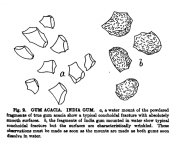Acacia senegal (gum)
Contents |
Introduction
Introduction from Wikipedia, the free encyclopedia (http://en.wikipedia.org/wiki/Acacia_senegal, retrieved 02/20/2012). Acacia senegal is a small deciduous Acacia tree known by the common names Rfaudraksha, Gum Acacia, Gum Arabic Tree, or Gum Senegal Tree. It is native to semi-desert regions of Sub-Saharan Africa, as well as Oman, Pakistan, and northwestern India. It grows to a height of 5-12m, with a trunk up to 30 cm in diameter. A. senegal is the source of the world's highest quality gum arabic, known locally as hashab gum in contrast to the related, but inferior, gum arabic from A. seyal or talh gum.
The tree is of great economic importance for the gum arabic it produces to be is used as a food additive, in crafts, and as a cosmetic. The gum is drained from cuts in the bark, and an individual tree will yield 200 to 300 grams. Seventy percent of the world's gum arabic is produced in Sudan.
The quoted text in this section was licensed for use under the Creative Commons ShareAlike License, version 3.0: http://creativecommons.org/licenses/by-sa/3.0/
Macroscopic Entries
Microscopic Entries
|
HPTLC Entries
Other Points of Interest
Cite error: <ref> tags exist, but no <references/> tag was found
